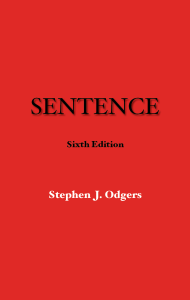
Sentence is a comprehensive discussion of the law of sentencing in NSW Courts for State and Federal offences.
Stephen Odgers S.C. is well suited to providing an incisive analysis of sentencing law, using his extensive experience as a barrister and his background in both law reform and academia.
This work covers the procedures that apply in NSW courts when sentencing offenders, the general principles that those courts must apply when determining an appropriate sentence for an offender, the factors that are commonly taken into account when sentencing an offender, and the available sentencing options. It also discusses discrete NSW sentencing courts and the applicable principles relating to appeals against sentence and other forms of review. Finally, there is a discussion of some possible avenues of reform of sentencing law.
Click here to see the sample chapter Procedure. Sentence online is updated by the author on a regular basis. Updates from the sixth edition are highlighted.
The analysis is comprehensive and detailed, with reference to hundreds of appellate judgments. For example, chapter 4, dealing with factors bearing on the determination of sentence, provides full discussion of the following factors:
- objective seriousness
- motivation
- planning
- state of mind
- capacity to avert the offence
- entrapment
- age
- health
- mental abnormality
- intoxication
- addiction
- childhood disadvantage
- cultural background
- good character
- prior convictions
- prospects of rehabilitation
- future dangerousness
- repeat offending
- conditional liberty
- unlawfully at large
- plea
- assistance
- remorse
- voluntary cessation of offending
- ameliorative conduct
- assistance provided by others
- attitude of victim
- delay
- could have been sentenced in different court
- could have been charged with a lesser offence
- prior punishment
- non-curial punishment
- unrelated curial punishment
- anticipated impact of sentence on offender
- anticipated impact of sentence on third parties
- potential executive action
The applicable legislation is extracted. For example, chapter 5, dealing with sentencing options, contains all the relevant statutory provisions (along with detailed analysis) relating to the following options:
- no conviction recorded
- conviction with no other penalty
- good behaviour bond
- intervention program
- community service order
- community clean up work order
- reparation order
- non-association and place restriction orders
- licence disqualification
- fine
- suspended sentence of imprisonment
- home detention
- intensive corrections order
- compulsory drug treatment order
- imprisonment
- pronouncement as an “habitual criminal”
The analysis is also, in many respects, innovative. For example, twenty principles of sentencing are distilled in chapter 3:
- the purposes of sentencing must be taken into account
- factors relevant to the determination of sentence must be taken into account in an instinctive synthesis (the “instinctive synthesis principle”)
- advancement of systemic goals permits an exception to the instinctive synthesis principle
- the guidance provided by sentencing “guideposts” must be taken into account
- the sentencing court should seek to reflect legitimate community expectations
- the sentencing court should generally lean towards mercy
- a sentence may not be imposed solely to protect the community (the “proportionality principle”)
- a sentence reduced in order to advance systemic goals “must not be unreasonably disproportionate to the nature and circumstances of the offence”
- there must be reasonable consistency in sentences
- there must not be disparate sentences for co-offenders (the “parity principle”)
- there must not be punishment for unforeseeable consequences
- there must not be punishment for another offence
- another offence that has been formally admitted may be taken into account at the request of the offender
- there must not be double punishment
- there must not be double counting
- when sentencing for more than one offence, account must be taken of the “totality” of the circumstances (the “totality principle”)
- there should be restraint when re-sentencing (the “ceiling principle”)
- there must not be prospective sentencing if that would result in a heavier sentence
- imprisonment is a sentence of last resort
- a sentencing court should engage in a final review before imposing sentence
Sentencing captures the attention of media outlets and the imagination of the public like no other aspect of the Australian criminal justice system. This work attempts to provide assistance to judicial officers in NSW in performing that sentencing task, help to those who participate in the sentencing process, and informs those who wish to understand how offenders are sentenced in NSW courts.
